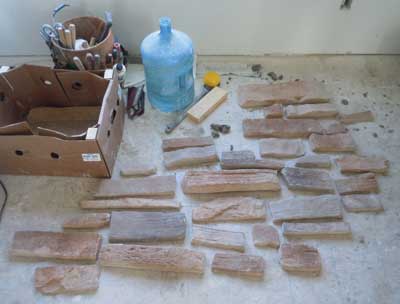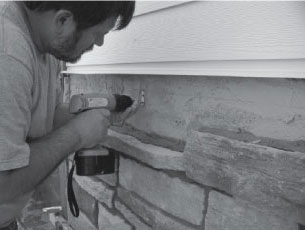Now that you know which stone veneer product you want to use, you may be asking yourself: "How do I install stone veneer?" Don't worry! We've got you covered. Below is our step by step guide to help you learn how to install stone veneer. The following is a broad outline for installing Cast Natural Stone. For complete specifications and guidelines, please visit
www.culturedstoneveneer.com and click on Installation Guide.
General
Careful and proper installation is important for ensuring the long-lasting beauty of your Cast Natural Stone. For all exterior applications, required installation includes a scratch coat (also known as cement plaster coating) over a water-resistive barrier. The water-resistive barrier generally consists of two layers of properly applied Grade D paper, which is then covered with metal lath and a mortar scratch coating (cement plaster).
Installation over rigid sheathing:
The metal lath/scratch coating may be applied over structurally sound wall surfaces of plywood, OSB, concrete board or gypsum sheathing, supported by wood or steel studs, and over concrete or masonry walls.

Step 1: Surface Preparation
Apply two layers of Grade D weather resistant building paper or equivalent over rigid sheathing. Install from the bottom up ensuring upper layer laps lower at least four inches. Weep screeds should be installed at bottom. [Flashing, as applicable by building codes should be installed at all sill, window and other wall penetration junctures] Important, be sure that all weep screeds and flashings are installed properly.
For the metal lath, attach 2.5 lb. expanded, galvanized, metal lath to each stud 6” on center-vertically, penetrating the studs at least one inch. Be sure to attach the lath horizontally. The surface should feel rough as you rub your hand upward. Install lath with a minimum 1” overlap on horizontal and vertical seams. Lath on inside and outside corners should be wrapped completely around the corner to the next stud and attached every 6”.
NOTE:
Before nailing down lath, be sure building paper is installed smooth. Lath needs to be tight; any bubbles should be nailed or stapled down to prevent “bounce”.
Special Note for Concrete and Masonry Surfaces: manufactured Stone Veneer can be installed directly to clean, unpainted or unsealed brick, concrete block or poured concrete surfaces (interior or exterior) without requiring the use of metal lath. On previously coated surfaces, sandblast or waterblast to thoroughly clean. Where thorough cleaning is not possible, instal
l metal lath and apply a scratch coat application.
Special Note for Interior Applications:
Same installation techniques apply, though flashing and weep screeds may not be necessary.
 Step 2: Scratch Coat Application
Step 2: Scratch Coat Application
All lathed surfaces should be covered with a 1/2” to 3/4” coat of Type N, or Type S mortar and allowed to set approximately 30 minutes prior to installing stones. Then brush with a soft bristled brush (to roughen up surface to ensure a stronger mechanical and chemical bond.). Typical mortar mix consists of one part type “N” or “S” cement and 2.25 parts sand. Mix with enough water to achieve a workable consistency. The same mortar mixture is used for scratch coating, setting the stone and grouting the joints. Dry pre-mixed mortars, especially designed for masonry, may also be used. Ask your Menards representative for specific product recommendations and mixing instructions.
 Step 3: Stone Layout and Arrangement
Step 3: Stone Layout and Arrangement
Before stone installation, lay out a quantity near the work area. Blend multiple boxes to ensure a proper mix of size, shape, texture and color of stones allowing you to arrange the stones in the most pleasing design. Then apply stones, mixing colors randomly.
 Step 4: Application
Step 4: Application
“Butter” the stone by applying an even, 1/2 inch thick layer of mortar to the back of the stone. Be sure to cover the entire back of the stone with mortar. Press the stone firmly into place so that the mortar behind the stone squeezes out on all sides. Use a wiggle action while applying the stone to insure a good bond. When applying to clean, concrete and masonry surfaces, dampened the wall prior to installation. This will aid adhesion to the existing surface. Adhesion can also be improved by adding a liquid bonding agent to the mortar mix.
Tip: Install the corner stones first starting at the bottom and working up. Install the balance of the wall from the top down. This aids in keeping the stone face clean of mortar.
Remove mortar from stone face, as necessary, during installation. Allow mortar to become “crumbly”, then remove with a trowel or brush. Do not allow mortar on stone surface to dry overnight.
When necessary, stones can be cut and shaped with a masonry hammer, masonry saw or nippers. Position cut edges away from view when possible. Trimmed edges are easily concealed at grouting.
 Step 5: Grouting the Joints
Step 5: Grouting the Joints
After the stone has been applied to the surface, fill a grout bag with mortar and as in decorating a cake, fill the joints with mortar. Grout bags are available from your supplier. While grouting, be sure to cover any noticeable broken or cut edges with mortar.
Step 6: Striking the Joints
When the mortar joints become firm, use a wood or metal strike tool to push the mortar into any cavities or voids creating a seal around each stone. Any holes, gaps, or voids must be filled in with mortar to prevent water or pests from occupying the space. Use a tuck pointer or similar object to clean the edges of each stone to prevent cracking of the grout. Use pressure to force the mortar into the joints. This will thoroughly seal the joint edges. Be careful not to work the joints too soon. This will cause the mortar joints to smear.
Step 7: Brushing
Brush the mortar joints with a small whisk broom to smooth and clean away any loose mortar.
Do not wash off with clear water. This will result in a milky residue. Brush off any mortar spots from the face of the stone veneer. If desired, use a mild vinegar and water solution to remove any remaining mortar spots. Loose mortar and mortar spots should not be allowed to dry overnight.
Step 8: Completion
When desired, a high quality “breathable” masonry sealer can be applied on any stone veneer, especially on those exposed to severe freezing and thawing, excessive moisture, or conditions which could discolor or stain the veneer. This must be a breathable, masonry sealer. Any other type of sealer voids the warranty. Follow recommended application instructions for your selected sealer. Test several unused pieces before general application. Some sealers may alter the appearance of the masonry.
Step 9: Cleaning
During the stone application remove all mortar on the face of the stone by allowing the mortar to set-up until crumbly, then remove with a dry bristle brush. Do not allow mortar on stone surfaces to dry completely.
To remove dirt, smoke or other stains, use a mild solution of granular detergent and water. Scrub with a bristle brush and rinse with fresh water. Do not use wire brushes. Do not use acid, salt or other “de-icing” materials. They will cause damage to concrete and masonry materials. CAST NATURAL STONE is not warrantied against deterioration or discoloration caused by acid, salt or other chemical or cleaning agents.
 Typical Sill & Lintel Installation
Typical Sill & Lintel Installation
Determine Placement
Determine the height at which you would like the top of your sill or lintel. Subtract 2.5" to compensate for sill and lintel height. Snap or draw a plumb line at this height. This will give you a reference line to work from.
Fasten L Brackets
Fasten 2"x2" zinc coated angle "L" brackets so the top is flush and level with your reference line; apply 3 brackets for every sill/lintel piece to rest on. Apply 4 brackets for 48" lintel.
Mortar
Mortar the back of the sill/lintel and apply to surface allowing it to rest on the angle brackets
Caulk
Caulk the joint along the back of the sill/lintel and the building. Then cover it with flashing
Finish Stone Application

 Step 2: Scratch Coat Application
Step 2: Scratch Coat Application Step 3: Stone Layout and Arrangement
Step 3: Stone Layout and Arrangement Step 4: Application
Step 4: Application Step 5: Grouting the Joints
Step 5: Grouting the Joints Typical Sill & Lintel Installation
Typical Sill & Lintel Installation